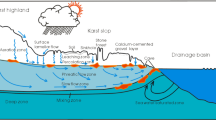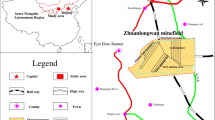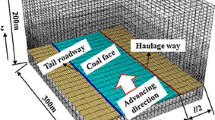Abstract
In the Huainan Coalfield of China, the hazards posed by mine water are becoming more serious with increasing mining depth. Groundwater is mainly transported through tectonic fractures in coal measure strata. Therefore, the identification of fractures in coal measure strata aids in determining whether or not a target coal seam will suffer water hazards. Here, we introduce a prediction method of mine water hazards based on the comprehensive analysis of seismic and logging data using the Permian coal strata of the Huainan Coalfield in China. We used seismic data to locate tectonic fractures, and then selected an appropriate place to drill an exploration well, where dipole acoustic logging data were utilized to finely predict the strata with relatively well-developed fractures. Finally, according to the prior knowledge of the hydrogeology and water inrush of the upper mined coal seams, we concluded that the target strata were likely to contain groundwater and would aggravate the hazard posed by water inrush when the under-group coal seams were mined.







Similar content being viewed by others
References
Abraham JD, Cannia JC, Peterson SM, Smith BD, Minsley BJ, Bedrosian PA (2010) Using airborne geophysical surveys to improve groundwater resource management methods. In Symposium on the application of geophysics to engineering and environmental problems 2010, Society of Exploration Geophysicists, pp 309–314. https://doi.org/10.4133/1.3445449
Aizebeokhai A, Oyeyemi K, Joel E (2016) Electrical resistivity and induced-polarization imaging for groundwater exploration. In SEG Technical Program Expanded Abstracts 2016, Society of Exploration Geophysicists, pp 2487–2491. https://doi.org/10.1190/segam2016-13857737.1
Bernard J, Legchenko A (2003) Groundwater exploration with the magnetic resonance sounding method. In ASEG Extended Abstracts 2003, Australian Society of Exploration Geophysicists, pp 1–5. https://doi.org/10.1071/ASEG2003ab013
Bush I, Crampin S (1987) Observations of EDA and PTL anisotropy in shear wave VSPs. In SEG Technical Program Expanded Abstracts 1987, Society of Exploration Geophysicists, pp 646–649. https://doi.org/10.1190/1.1892023
Chaimov TA, Beaudoin GJ, Haggard WW, Mueller MC, Thomsen LA (1995) Shear-wave anisotropy and coalbed methane productivity. In SEG Technical Program Expanded Abstracts, Society of Exploration Geophysicists, pp 305–308. https://doi.org/10.1190/1.1887468
Chen ST (1988) Shear-wave logging with dipole sources. Geophysics 53(5):659–667. https://doi.org/10.1190/1.1442500
Chen XL, Tang XM (2013) Simulation of multipole acoustic logging in cracked porous formations. Geophysics 79(1):616–620. https://doi.org/10.1190/geo2013-0163.1
Crampin S (1989) Suggestion for a consistent terminology for seismic anisotropy. Geophys Prospect 37(7):753–770
Crampin S, Chesnokov EM, Hipkin RG (1984a) Seismic anisotropy–the state of the art: II. Geophys J Int 76(1):1–16. https://doi.org/10.1111/j.1365-246X.1984.tb05017.x
Crampin S, Evans R, Atkinson BK (1984b) Earthquake prediction: a new physical basis. Geophys J Int 76(1):147–156. https://doi.org/10.1111/j.1365-246X.1984.tb05030.x
Esmersoy C, Koster, K, Williams M, Boyd M, Kane M (1994) Dipole shear anisotropy logging. In SEG Technical Program Expanded Abstracts 1994, Society of Exploration Geophysicists, pp 1139–1142. https://doi.org/10.1190/1.1822720
Farrell DA, Sandberg SK, Barnes H, Browne J, Sutherland A, Humphrey J, Mayers BL, Weller J (2005) Geophysical characterization of seawater intrusion in Antigua, West Indies. In Symposium on the Application of Geophysics to Engineering and Environmental Problems 2005, Society of Exploration Geophysicists, pp 608–620. https://doi.org/10.4133/1.2923513
Fechner T, Ketelhodt JV, Mackens S (2017) Structure delineation using S-wave reflection seismic and borehole tomography to support groundwater modelling. In Symposium on the Application of Geophysics to Engineering and Environmental Problems 2017, Society of Exploration Geophysicists, pp 238–242. https://doi.org/10.4133/SAGEEP.30-017
Flores RM (1998) Coalbed methane: from disaster to resource. Coal Geol 35(1–4):3–26
Gui HR, Song XM, Lin ML (2017) Water-inrush mechanism research mining above karst confined aquifer and applications in North China coalmines. Arab J Geosci 10(7):180. https://doi.org/10.1007/s12517-017-2965-5
Han J, Shi LQ, Yu XG, Wei JC, Li SC (2009) Mechanism of mine water-inrush through a fault from the floor. Min Sci Technol 19(3):276–281. https://doi.org/10.1016/S1674-5264(09)60052-1
Hanafy SM (2013) Groundwater aquifer characterization using geophysical methods. In Symposium on the Application of Geophysics to Engineering and Environmental Problems 2013, Society of Exploration Geophysicists, pp 411–414. https://doi.org/10.4133/sageep2013-143.1
Hardy S, Ford M (1997) Numerical modeling of trishear fault-propagation folding. Tectonics 16(5):841–854. https://doi.org/10.1029/97TC01171
Heinson G, Inverarity K, Pedler-Jones D, Costar A, Wurst S, McLean G, Simmons C (2010) Locating groundwater resources for aboriginal communities in remote and arid parts of South Australia. In SEG Technical Program Expanded Abstracts 2010, Society of Exploration Geophysicists, pp 3844–3847. https://doi.org/10.1190/1.3513650
Huang YP, Dong SH, Geng JH (2009) Ordovician limestone aquosity prediction using nonlinear seismic attributes: case from the Xutuan coal mine. Appl Geophys 6(4):359–366. https://doi.org/10.1007/s11770-009-0043-9
Huang Z, Jiang ZQ, Qian ZW, Cao DT (2014) Analytical and experimental study of water seepage propagation behavior in the fault. Acta Geodyn Geomater 11(4):361–370. https://doi.org/10.13168/AGG.2014.0017
Hubbert MK, Willis D (1957) Mechanics of hydraulic fracturing. Trans Am Inst Min Metall Petrol Eng 210:153–166
Leeming P, Moehadu, M, Nikiel-Tshabangu B, Sarma D (2001) An integrated approach with DighemV to groundwater exploration? Tsabong, Botswana. In ASEG Extended Abstracts 2001, Australian Society of Exploration Geophysicists, pp 1–4. https://doi.org/10.1071/ASEG2001ab069
Legchenko A, Baltassat JM, Vouillamoz JM (2003) A complex geophysical approach to the problem of groundwater investigation. In Symposium on the Application of Geophysics to Engineering and Environmental Problems 2003, Society of Exploration Geophysicists, pp 739–757. https://doi.org/10.4133/1.2923219
Li XQ, Li YN (2014) Research on risk assessment system for water inrush in the karst tunnel construction based on GIS: case study on the diversion tunnel groups of the Jinping II Hydropower Station. Tunn Undergr Space Technol 40:182–191. https://doi.org/10.1016/j.tust.2013.10.005
Li GY, Mou L, Zhou WF (2015) Paleokarst crust of Ordovician limestone and its utilization in evaluating water inrushes in coalmines of North China. Carbonates Evaporites 30(4):365–371. https://doi.org/10.1007/s13146-015-0231-z
Luo MM, Chen ZH, Zhou H, Jakada H, Zhang L, Han ZF, Shi TT (2016) Identifying structure and function of karst aquifer system using multiple field methods in karst trough valley area, South China. Environ Earth Sci 75(9):824. https://doi.org/10.1007/s12665-016-5630-5
Manzi MSD, Durrheim RJ, Hein KAA, King N (2012) 3D edge detection seismic attributes used to map potential conduits for water and methane in deep gold mines in the Witwatersrand basin, South Africa. Geophysics 77(5):WC133–WC147. https://doi.org/10.1190/geo2012-0135.1
Mueller MC (1995) Interpretation of a dipole shear anisotropy log in a thrust belt setting. In SEG Technical Program Expanded Abstracts 1995, Society of Exploration Geophysicists, pp 484–487. https://doi.org/10.1190/1.1887347
Nelson R (1985) Geologic analysis of naturally fractured reservoirs, 2nd edn. Gulf Publishing Company, Houston
Pettifer G, Wood W (2004) Bundaberg groundwater investigation, Australia–a case for the benefits of extensive use of geophysics in groundwater investigations. In Symposium on the Application of Geophysics to Engineering and Environmental Problems 2004, Society of Exploration Geophysicists, pp 912–935. https://doi.org/10.4133/1.2923407
Strayer LM, Hudleston PJ (1997) Numerical modeling of fold initiation at thrust ramps. J Struct Geol 19(3–4):551–556. https://doi.org/10.1016/S0191-8141(96)00109-5
Tsvankin I (1997) Reflection moveout and parameter estimation for horizontal transverse isotropy. Geophysics 62(2):614–629. https://doi.org/10.1190/1.1444170
Ulugergerli E, Lima JPR, Raulino N (2007) Joint evaluation of electromagnetic and electric methods for groundwater exploration. 10th International Congress of the Brazilian Geophysical Society & EXPOGEF 2007, Society of Exploration Geophysicists and Brazilian Geophysical Society Rio de Janeiro, Brazil, pp 123–127. https://doi.org/10.1190/sbgf2007-025
Vincenz SA (1968) Resistivity investigations of limestone aquifers in Jamaica. Geophysics 33(6):980–994. https://doi.org/10.1190/1.1439992
Wang Y, Gao Y, Jie MX (2003) The prediction of fractured zone in coal-series strata. J China Coal Soc 28(6):566–568
Wang SZ, Xu G, Guo M, Li ZQ (2016) Integrated numerical simulation stress field and seismic attribute to predict shale fracture distribution. In Unconventional Resources Technology Conference, San Antonio, Texas, Society of Exploration Geophysicists, American Association of Petroleum Geologists, Society of Petroleum Engineers, pp 165–174. https://doi.org/10.15530/urtec-2016-2428463
Winterstein D (1992) How shear-wave properties relate to rock fractures: simple cases. Lead Edge 11(9):21–28. https://doi.org/10.1190/1.1436900
Zhang JC (2005) Investigations of water inrushes from aquifers under coal seams. Int J Rock Mech Min Sci 42(3):350–360. https://doi.org/10.1016/j.ijrmms.2004.11.010
Acknowledgments
We are grateful to the Huainan Mining Group for providing the research data.
Funding
This research was supported by the National Natural Science Foundation of China [grant nos. 41574126 and 41425017] and by the Fundamental Research Funds for the Central Universities [grant no. 2-9-2017-452].
Author information
Authors and Affiliations
Corresponding author
Rights and permissions
About this article
Cite this article
Qin, Y., Lu, J. Prediction of coal mine water hazards: a case study from the Huainan Coalfield. Arab J Geosci 12, 83 (2019). https://doi.org/10.1007/s12517-019-4263-x
Received:
Accepted:
Published:
DOI: https://doi.org/10.1007/s12517-019-4263-x




